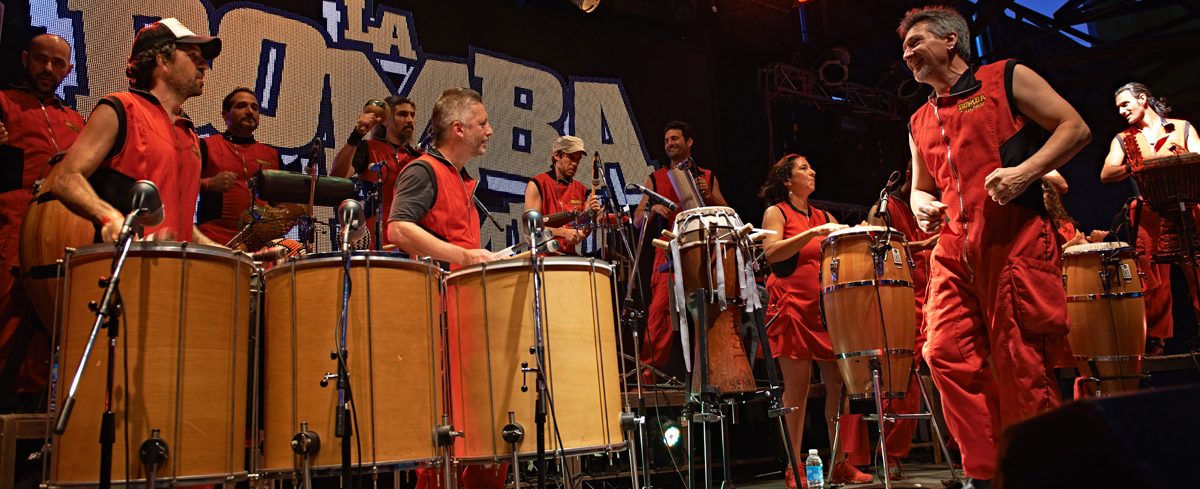The beating heart of the Abasto.

"When you're in Buenos Aires, you have to go to La Bomba," people had told me. "They're . . . well, the bomb." And so on a Monday evening, after hopping off the subte metro system at Carlos Gardel station, I find myself in the middle of the bustling neighbourhood people call the Abasto. It's actually part of the larger neighbourhood of Balvanera, but people call this part of the neighbourhood Abasto because of the Art Deco former market, now shopping centre of the same name. It's the neighbourhood of legendary tango singer Carlos Gardel, but nowadays it's also gained fame for a very different form of music that's already become a modern legend.
La Bomba del Tiempo (The Timebomb) is a percussion group so sensational that after more than a decade, they continue to pack out the Ciudad Cultutal Konex every Monday evening. It's approaching 8pm, fairly early for a night out in Buenos Aires, but there's already a palpable feeling of excitement and expectation among the crowd at this industrial site turned avant garde cultural venue. There's a feeling among the crowd, or better said, a knowledge; a certainty, that we're all in the right place, at the right time, with the right people, to experience something extraordinary.

Here come the drums

A rapturous applause, a push of bodies as people inch closer to the stage, and 16 guys dressed in red emerge onto the stage, take their positions behind the drums, and, without saying a word, calmly start to tap out the first beats. It's not a dramatic, urgent start, but actually very relaxed; the pauses and looks and gestures between the percussionists indicating that an almost casual improvised jam is going on, but the easy rhythms begin to loosen limbs and bodies, drawing the crowd into a ritual in which the need to move, and express the rhythm begins to catch contagiously in the crowd, flowing from person to the next, uniting those present.

The ticking timebomb
The rhythm continues to build, and it begins to feel that as time passes, the musicians are increasing the intensity, raising the temperature, and lifting spirits higher. The group practises percussion with signs, improvising rhythms in real time using a system of more than 100 gestures to communicate, which keeps the crowd constantly on their toes, wondering which direction the rhythm is going to take. Like a ticking timebomb, the beat seems to be getting more urgent as we approach a climax. But it isn't predictable, they play with us and surprise us too. In the middle of the show a trumpet player apppears on the stage to add extra shades to the sound of the percussion, and an ice cold beer is in order to sate the first that's been building up.
When the musicians finally leave the stage, I can't believe that two hours have passed so quickly. Of course, the crowd clamours for more, yelling "otra, otra," and it's not long before the group's back on stage and at full pelt once more, a few extra minutes of rhythm that the crowd use to the max to finish the show dancing and shouting like crazy. The bomb has exploded.

The aftermath of the explosion

Such an explosion could leave bodies spent, stumbling home. But on leaving the venue, planning to wander back to the subte station, I discover that it's not over yet. In the middle of the street outside another group of percussionists is waiting for us. There are a lot of people; so many that cars can't pass. As the cars beep their horns, the organisers corral us onto the sidewalk behind a rope, and together we all advance following the percussionists through the streets of the Abasto, dancing and laughing. Where are they taking us? To a nightclub, it turns out! The party hasn't finished yet! It's a Monday night, but we're staying out dancing until the early hours. The Bomba del Tiempo was the highlight rather than the warm-up act, but they've left everyone loosened up and in the mood to continue dancing for a while more.

Based on an article originally written by Agustín Suárez.
Learn more about music in Buenos Aires.
